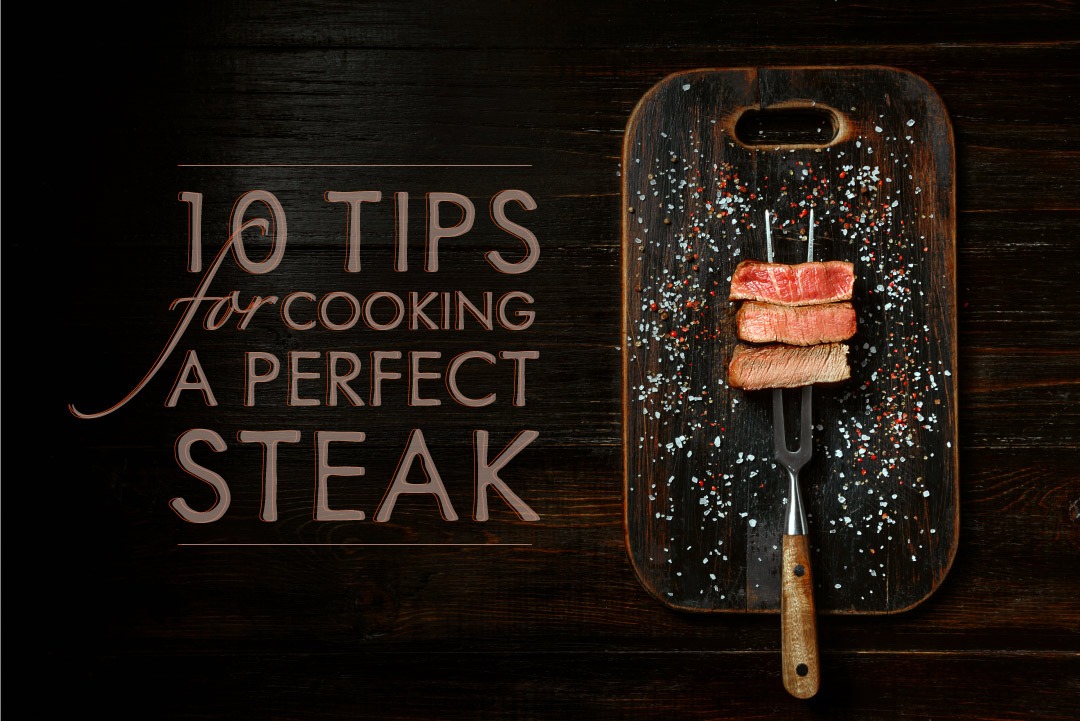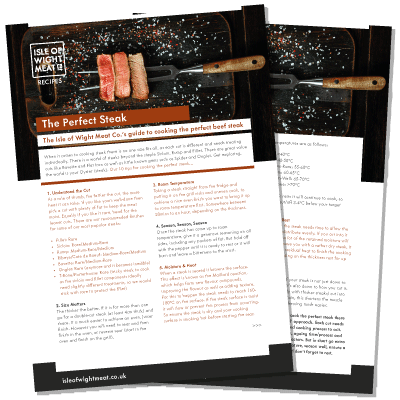10 Tips for Cooking a Perfect Steak

The Isle of Wight Meat Co.’s guide to cooking the perfect beef steak.
When it comes to cooking steak there is no one size fits all, as each cut is different and needs treating individually. There is a world of steaks beyond the staple Sirloin, Rump and Fillet. There are great value cuts like Bavette and Flat Iron as well as little known gems such as Spider and Onglet. Get exploring, the world is your Oyster (steak).
Our 10 tips for cooking the perfect steak…
1. Understand the Cut
As a rule of thumb, the fattier the cut, the more heat it can take. If you like yours well-done then pick a cut with plenty of fat to keep the meat moist. Equally if you like it rare, head for the leaner cuts. These are our recommended finishes for some of our most popular steaks:
- Fillet: Rare
- Sirloin: Rare/Medium-Rare
- Rump: Medium-Rare/Medium
- Ribeye/Cote de Boeuf: Medium-Rare/Medium
- Bavette: Rare/Medium-Rare
- Onglet: Rare (anymore and it becomes inedible)
- T-Bone/Porterhouse: Rare (tricky steak to cook as the sirloin and fillet components ideally need slightly different treatments, so we would stick with rare to protect the fillet)
2. Size Matters
The thicker the better. If it is for more than one go for a double-cut steak (at least 4cm thick) and share. It is much easier to achieve an even, juicer finish. However you will need to sear and then finish in the oven, or reverse sear (start in the oven and finish on the grill).
3. Room Temperature
Taking a steak straight from the fridge and putting it on the grill risks and uneven cook, to achieve a nice even finish you want to bring it up to room temperature first. Somewhere between 20mins to an hour, depending on the thickness.
4. Season, Season, Season
Once the steak has come up to room temperature, give it a generous seasoning on all sides, including any pockets of fat. But hold off with the pepper until it is ready to rest or it will burn and leave a bitterness to the crust.
5. Moisture & Heat
When a steak is seared it browns the surface. This effect is known as the Maillard reaction (see link here), which helps form new flavour compounds, improving the flavour as well as adding texture. For this to happen the steak needs to reach 160-180°C on the surface. If the steak surface is moist it will slow or prevent this process from occurring. So ensure the steak is dry and your cooking surface is smoking hot before starting the sear.
6. Flat Bottomed Pan
Griddle pans with grooves should be avoided. They may look great for instagram posts but they do nothing in terms of imparting flavour into the meat. You end up with bitter charred lines and grey (with no Maillard) in-between. Stick to a flat heavy-based frying pan to get that all-over even Maillard crust.
7. Keep it Moving
There had been (and maybe still is) a school of thought that argued turning once was enough. However if you want an even Maillard reaction on the surface it is best to keep them moving, turning regularly. And make sure you sear the sides during the process, especially any fat covering.
8. Gauging the Finish
The traditional method of gauging the finish on the steak is to measure the firmness. Seasoned professionals will simply press the steak and know, but as a rough guide you can match the firmness to part of your hand. Find the area of flesh around the thumb joint (known as the Thenar), hold your index finger and thump tip-to-tip and press down on the Thenar – this is the firmness of a rare steak. Switch the index finger with your middle finger and you have medium rare, ring finger and thumb = medium and so on.
The downside to this technique is that our hands and steaks vary. So if you want the perfect steak every time the best solution is to use a digital thermometer. We recommend the Meater, a wireless thermometer with supporting app.
Finish temperatures are as follows:
- Blue: <40°C
- Rare: 40-50°C
- Medium-Rare: 55-60°C
- Medium: 60-65°C
- Medium-Well: 65-70°C
- Well-done: >70°C
As the steak rests it will continue to cook, so whip them out/off 3-4°C below your target temperature.
9. Rest, Rest, Rest
After cooking the steak needs time to allow the moisture to redistribute evenly. If you cut into it straight away a lot of the retained moisture will seep out and leave you with a rather dry steak. It also allows the residual heat to finish the cooking process. Depending on the thickness rest for up to 20 minutes.
10. The Cut
The tenderness of your steak is not just down to how you cook it, it’s also down to how you cut it. To serve (especially with thicker steaks) cut into slices across the grain, this shortens the muscle fibres and makes chewing much easier.
So to summarise, to cook the perfect steak there is no ‘one size fits all’ approach. Each cut needs its own evaluation and cooking process to suit. Type of cut, thickness, ageing time/process and fat marbling are all factors. But in short go extra thick, at room temperature, season well, ensure a good all-over sear and don’t forget to rest.


